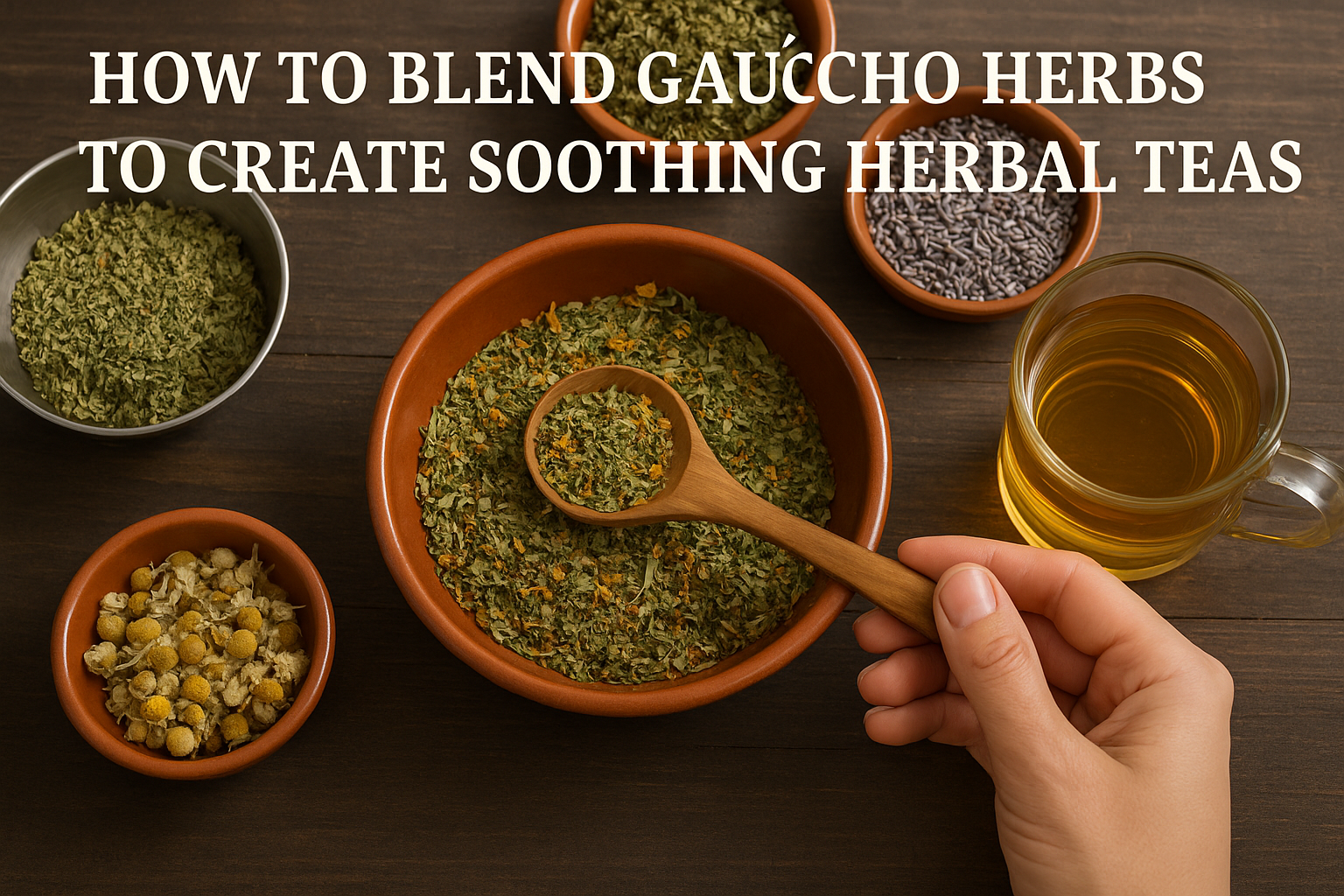The culture of Southern Brazil is deeply tied to herbs. From the pampas to urban markets, plants play a central role in rituals, remedies, and daily comfort.
Among the most enduring traditions is the preparation of herbal teas. These infusions go beyond taste, carrying history, wellness, and cultural identity in every sip.
Blending Gaúcho herbs into teas is an art. It requires knowledge of the plants, respect for tradition, and sensitivity to flavors. By exploring this practice, we discover not only soothing drinks but also a living link to Gaúcho heritage.
The Tradition of Herbal Teas in Gaúcho Culture
Herbal teas have long been part of Gaúcho households. They were prepared to calm the body, ease discomfort, or simply provide warmth during cold winters. Families relied on the land around them, collecting native herbs and drying them for year-round use.
Over time, the teas became cultural symbols. They represented hospitality, care, and community. Offering a guest a cup of herbal tea was as much an act of kindness as it was a remedy.
The Most Common Gaúcho Herbs for Tea
Certain herbs became staples of tea-making traditions. Each carries its own unique qualities and associations.
- Marcela (Achyrocline satureioides): Traditionally harvested around Easter, marcela is known for its calming and digestive properties. Its gentle golden flowers bring both aroma and symbolism to teas.
- Boldinho (Peumus boldus): Often used for digestive relief, boldinho leaves carry a slightly bitter flavor. They are valued in folk medicine and remain a common ingredient.
- Rosemary (Rosmarinus officinalis): Associated with protection and mental clarity, rosemary adds a refreshing and slightly pine-like taste to infusions.
- Mint (Mentha spp.): Cooling and invigorating, mint blends easily with other herbs to lighten flavors.
- Lemon balm (Melissa officinalis): Known for its soothing effect on nerves, lemon balm has a soft citrus profile that makes teas gentle and pleasant.
These plants are often combined, creating blends that balance flavors and enhance effects.
The Art of Blending Herbs
Blending herbs is more than mixing leaves together. It is a careful process that respects both the plants and the people who will drink them.
A successful blend considers three aspects:
- Flavor balance: Stronger herbs, such as boldinho, must be combined with milder ones like marcela to create harmony.
- Purpose: Teas may be designed for relaxation, digestion, or refreshing energy. The choice of herbs reflects the desired effect.
- Cultural meaning: Some blends carry symbolic weight, used in specific seasons or rituals.
By blending with intention, teas become more than beverages; they become cultural expressions.
Seasonal Influences in Blending
Seasonality plays a role in which herbs are chosen. During colder months, boldinho and rosemary are common, providing warmth and strength. In summer, mint and lemon balm dominate, offering freshness and lightness.
Special occasions also influence blends. Easter teas often highlight marcela, while family gatherings may feature combinations meant to promote digestion after heavy meals.
Preparing the Herbs
Before blending, herbs must be properly prepared. Harvesting at the right time ensures potency. Drying is essential, allowing plants to retain their qualities while preventing mold.
Dried herbs are usually crushed lightly to release aroma but kept large enough to avoid turning to powder. This balance maintains both flavor and visual appeal in the blend.
Methods of Brewing Gaúcho Herbal Teas
The brewing process is as important as the blend itself. Two methods dominate:
- Infusion: Hot water is poured over herbs, covered, and left to steep for several minutes. This method suits delicate flowers such as marcela.
- Decoction: Herbs are simmered gently in water, a technique used for tougher leaves like boldinho.
In both methods, Gaúcho families emphasize patience. Allowing the herbs to rest fully in water ensures the release of both flavor and properties.
Balancing Flavors in Practice
A common blend for relaxation might include marcela, lemon balm, and mint. Marcela provides calmness, lemon balm softens the nerves, and mint brightens the taste.
For digestion, boldinho is often paired with rosemary. The bitterness of boldinho is tempered by rosemary’s refreshing quality, making the tea both effective and pleasant.
These combinations are not fixed. Families often adapt blends based on availability and preference, creating unique household recipes.
The Social Role of Herbal Teas
In Gaúcho homes, herbal teas are rarely consumed alone. They are part of gatherings, served after meals, or during quiet conversations. Sharing tea reinforces social bonds and expresses hospitality.
Even today, offering tea to visitors remains a gesture of warmth. The act itself communicates respect, care, and cultural pride.
Teas and Rituals
Herbal teas are also linked to rituals. Drinking marcela tea at Easter is a practice filled with symbolism, connecting families to both nature and faith. Rosemary tea might be prepared during moments of renewal, marking beginnings or transitions.
These rituals ensure that herbal teas remain embedded in both spiritual and cultural life.
The Modern Revival of Herbal Blending
While industrialized teas are widely available, there is a revival of interest in traditional herbal blending. People seek authenticity, natural remedies, and cultural identity in their drinks.
Markets in Southern Brazil often sell dried herbs by the bundle, keeping traditions alive in urban spaces. Artisans also create pre-blended mixes, inspired by ancestral practices but adapted for modern consumers.
Health and Wellness Perspectives
Modern science has begun to study the properties of herbs long used in Gaúcho traditions. Research confirms that many plants, such as mint and lemon balm, have calming effects, while rosemary supports mental clarity.
This validation bridges folk knowledge with contemporary wellness, giving new credibility to old practices.
Growing Herbs at Home
Urban families often grow herbs in small gardens or pots, ensuring a fresh supply for teas. Rosemary thrives in balconies, mint spreads quickly in containers, and lemon balm adapts well to limited spaces.
Home cultivation strengthens the connection between modern households and the rural roots of Gaúcho herbalism.
Passing Knowledge Across Generations
Blending teas is often a skill taught by elders. Grandmothers in particular share recipes, teaching children how to identify, measure, and combine herbs.
This passing of knowledge ensures continuity. It also reinforces the role of herbal teas as more than drinks—they are carriers of memory and tradition.
Beyond the Pampas: Global Inspiration
Gaúcho herbal teas now inspire people outside Southern Brazil. Tourists who experience these blends often take home herbs or recipes, spreading the tradition abroad.
In global markets focused on natural wellness, Gaúcho blends represent authenticity and heritage. They remind the world of how regional practices can enrich international perspectives.
Creating Your Own Blend
For those who wish to experiment, start with a simple combination of marcela, mint, and lemon balm. Adjust proportions until the taste feels balanced. Add rosemary for energy or boldinho for digestion, depending on your needs.
Experimenting with blends allows individuals to connect with tradition while making it personal. Every blend can tell a story.
Final Thoughts
Blending Gaúcho herbs into teas is both art and heritage. Each cup reflects centuries of wisdom, care for the land, and cultural pride. From marcela’s golden flowers to rosemary’s sharp freshness, every plant contributes its voice.
By continuing these practices, we do more than create soothing teas. We honor the resilience of Gaúcho traditions and bring their warmth into modern homes.

Marcela Cardozo is passionate about Southern Brazilian traditions and the cultural stories carried through natural scents. She blends knowledge of native herbs, essential oils, and regional rituals to create practical and inspiring content. Her writing connects ancestral wisdom with modern living, offering readers simple ways to bring authenticity, well-being, and meaning into their everyday lives.
